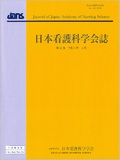Japanese
English
- 販売していません
- Abstract 文献概要
- 参考文献 Reference
要旨
目的:特別支援学校で学ぶ医療的ケア児への,口鼻腔内吸引や気管内吸引の実施に至るまでに,学校看護師が吸引の必要性をどのように判断しているのかを明らかにする.
方法:学校看護師18名に個別に半構造化インタビューを実施し,質的帰納的に分析した.
結果:学校看護師は,その場で医療的ケア児を観察して得た情報だけでなく,その子にとっての効果的な排痰パターン,その子の呼吸維持力の程度,吸引によるその子の変化といった経験を通して得た情報もあわせて,その子が吸引を待てる状況にあるかどうかを判断していた.吸引を待てると判断すると,教育活動を妨げないよう,その子の吸引の希望のサイン,保護者の判断や思い,教員や同僚看護師の判断をすり合わせ,吸引を実施する最適なタイミングを見つけていた.
結論:吸引実施の必要性を適切に判断するには,その子のことをよく知り,判断を他者と共有し,互いに学びあうことが重要である.
Aim: This study explored the nurses' clinical judgement of endotracheal and oral-nasal suctioning for technology-dependent children attending special needs schools.
Methods: A descriptive qualitative research design was used. Semi-structured interviews with 18 nurses working for technology-dependent children in Japanese special needs schools were conducted, and data were qualitatively and inductively analyzed.
Results: Nurses judged whether the endotracheal and oral-nasal suctioning was necessary based on not only the child's physical condition but also the empirical knowledge of the child's bronchial drainage patterns, the strength of keeping smooth respiration, and the effects of suctioning. Nurses found the best timing of suctioning not for interrupting educational activities with focusing parents' desires and drawing teachers' and other nurses' judgements.
Conclusions: Knowing the child and the parents' desires are important for nurses' clinical judgement of endotracheal and oral-nasal suctioning for technology-dependent children attending special needs schools. In addition to that, sharing judgements with others is essential to choose the best timing of suctioning.
Copyright © 2021, Japan Academy of Nursing Science. All rights reserved.


